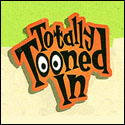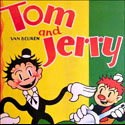 Got a question about classic cartoons? Maybe I can answer it. Or maybe not. I don’t know everything, but if I don’t know it, I probably know someone who does.
Got a question about classic cartoons? Maybe I can answer it. Or maybe not. I don’t know everything, but if I don’t know it, I probably know someone who does.
This page is for “simple questions” What’s a simple question? If I can answer it off the top of my head, or checking a quick reference, it’s a simple question. If you are looking for heavy duty research, that can be arranged for a fee.
First, Some Very Frequently Asked Questions
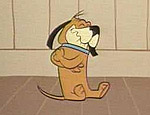 Do you recall the name of a cartoon that featured a dog, when given a treat, would float up into the air making happy, contented sounds, then slowly drift back down?
Do you recall the name of a cartoon that featured a dog, when given a treat, would float up into the air making happy, contented sounds, then slowly drift back down?
“Snuffles” was the name of the hound who went wild for dog biscuits. He was featured on Hanna-Barbera’s Quick Draw McGraw Show, as Quick Draw’s pet hound. Daws Butler voiced his “yummy sounds”. Snuffles snack-loving trait was later incorporated into the personality of Scooby Doo.
WHAT IS THE NAME OF MIGHTY MOUSE’S GIRLFRIEND?
This is the most frequently asked question coming into this website! The girlfriend in the operetta Terrytoons, Filmation TV cartoons or the Bakshi series was Pearl Pureheart. In the comic books her name was Mitzi.
IS TWEETY A BOY OR A GIRL?
A Boy. Tweety is a male canary.
DO YOU KNOW IF THE 1936 WARNER BROS. CARTOON “I LOVE TO SINGA” (by Tex Avery), FEATURING OWL JOLSON SINGING THE TITLE SONG, IS AVAILABLE ON ANY VIDEO COLLECTION?
Yes! It has been released on dvd on the LOONEY TUNES GOLDEN COLLECTION, Vol. 2. It is also a bonus feature on the DVD of the Oscar winning animated feature, HAPPY FEET.
Al Jolson introduced the song,I Love To Singa, in the feature film THE SINGING KID (1936). Tommy Bond (“Butch” from the OUR GANG shorts, “Jimmy Olsen” in the SUPERMAN serials) was the voice of “Owl Jolson”.
WHAT WERE THE NAMES OF THE TWO MALE GOPHER CHARACTERS IN LOONEY TUNES WHO WERE ALWAYS POLITE TO EACH OTHER?
They were usually billed as “The Goofy Gophers”. Later, on The Bugs Bunny Show (ABC, 1960) they were named “Mac & Tosh”.
WHO OWNS THE RIGHTS TO OUR FAVORITE CLASSIC CARTOONS?
WALT DISNEY cartoons (Mickey Mouse, Donald Duck, Goofy, et al) are owned by The Walt Disney Co.
TERRYTOONS (Mighty Mouse, Heckle & Jeckle, et al) are owned by Viacom (Paramount).
WALTER LANTZ CARTUNES (Woody Woodpecker, Chilly Willy, et al.) are owned by Universal Pictures.
SCREEN GEMS / COLUMBIA cartoons (Scrappy, Fox & Crow, et al) are owned by Columbia Pictures/Sony.
WARNER BROS. CARTOONS (Bugs Bunny, Daffy Duck, Tweety, et al) are all owned by Warner Bros.
UPA cartoons (theatrical 1950s Mr. Magoo, Gerald McBoing Boing, et al) are owned by Columbia Pictures/Sony.
UPA TV productions (Dick Tracy cartoons, Magoo Specials & TV cartoons, etc.) are owned today by Universal Pictures.
MGM CARTOONS (Tom & Jerry, Tex Avery) are owned by Warner Bros.
DePATIE-FRELENG CARTOONS (Pink Panther, Ant & Aardvark, et al) are now owned by MGM/Amazon Studios.
MAX FLEISCHER / FAMOUS STUDIOS / PARAMOUNT cartoons are divided all over the place. Here’s the breakdown:
• POPEYE CARTOONS are owned by Warner Bros. (Character owned by King Features/Hearst Entertainment)
• SUPERMAN CARTOONS are owned by Warner Bros. (Although all are in public Domain).
• FLEISCHER CARTOONS (includes Betty Boop, Screen Songs, KoKo The Clown (1927-1929), Animated Antics, Stone-Age and Color Classics) are owned by Paramount Pictures (Viacom). Olive Films have sub-licensed some Betty Boop cartoons for DVD and blu-ray.
• FAMOUS STUDIOS (1942-1950) (including Noveltoons and Little Lulu) are owned by Viacom (Paramount Pictures).
• FAMOUS STUDIOS (1950-1962) (includes Casper, Herman & Katnip, Noveltoons retitled as Harveytoons, etc) are owned by Universal Pictures.
• PARAMOUNT CARTOONS (1962-1967) (includes Honey Halfwitch, Swifty & Shorty, Noveltoons, etc) are still owned by Paramount Pictures.
WHY AREN’T THE CLASSIC 1950s COLOR PARAMOUNT POPEYE CARTOONS RELEASED ON VIDEO?
DVD sales began to tank after Warner Bros. restored and released the Fleischer black & white Popeyes several years ago, so the project to restore the rest of that library – the color theatricals released by Paramount – has been put on slow-motion. The color 1940s Paramount Popeye theatricals were released in three volumes by Warner Archive Collection in 2019. The 1950s Popeyes will be restored someday – we hope!
WHAT IS THE DIFFERENCE BETWEEN A “LOONEY TUNES” AND A “MERRIE MELODIES” CARTOON?
After the 1944 releases: nothing. Before that, there was a difference.
First Looney Tunes were established to be the showcase of Warner Bros. latest “star” character – at various times “Bosko” (1930-1933), “Buddy” (1933-1935), “Beans” (1936) and finally “Porky Pig” or “Daffy Duck” (1936-1943). One-shot no-star Looney Tunes were made, but they are rare. The Merrie Melodies were established to feature one-shot characters and miscellaneous stories and settings, particularly themed around a Warner Bros. owned song. In 1934 the studio began producing Merrie Melodies in color while the Looney Tunes remained in black & white. By 1940, stars Bugs Bunny, Elmer Fudd, Sniffles and Daffy Duck were regularly appearing in Merrie Melodies. In 1944 the Looney Tunes switched to color and the distinctions between the two series officially ended.
More Urgent Questions from the E-Mail bag:
Claudio Duckardt writes: I enjoy seeing the photos of Fleischer’s Miami Studio. I was hoping you could tell me more or less where the studio was actually located. I live in Miami, and would love to see if the building is still there.

As a matter of fact, the building is still there. Paramount built the Fleischer Studio in Miami in 1938 (photos above from Leslie Cabarga’s THE FLEISCHER STORY).
It was there that GULLIVER’S TRAVELS, MR. BUG GOES TO TOWN and the SUPERMAN cartoons were born. POPEYE, ANIMATED ANTICS, STONE AGE CARTOONS, RAGGEDY ANN and GABBY cartoons were also made there.
Paramount moved Famous Studios from Miami, back to New York in 1943. The Miami building was sold to TWA as a flight training school for pilots and stewardesses. It was later acquired by Dade County as a Family Planning & Youth Center. The building is still there at 1701 NW 30th Avenue (near the corner of NW 17th Street and 29th Ave.).
Cartoon Researcher Ken Layton says, “There is an excellent article (with photos!) detailing both interior and exterior of the Fleischer Miami studios in the January 1939 issue of “Architectural Record” magazine (pages 33, 34, 35, 36, and 37). The article is entitled, “Light, Sound, and Atmosphere Controlled In Studio Design” by C. Sheldon Tucker and John M. Lyell.
“If you don’t have access to a copy of that publication, your local public library may be able to obtain photocopies from: Washington State Library (phone: 360-753-5590) here in Olympia, Wash (catalog info: NA1.A65). They have actual paper originals in their storage dept.”
I visited the location myself in 1986 (see photos below).
 The original front entrance, now sealed off.
The original front entrance, now sealed off.
Below left, the center courtyard where Hal Seegar would play tricks on Joe Oriolo (I would imagine); At right, back of the building, outside the former scoring stage and screening room (now a gymasium).

Me, inside the gymasium which was the scoring stage and screening room. Notice the projection booth windows above the basketball hoop. I went up the staircase to the projection booth in hopes of finding some 35mm nitrate workprint materials or original Superman animation art – but alas, the room was completely empty. The friendly staff there had no idea that this building was originally a cartoon studio – and was grateful that I explained what this little empty room was above the gym.

Andrew L. asks: I know that Bugs Bunny makes a cameo appearence in the Paramount George Pal Puppetoon, JASPER GOES HUNTING (1944). Were there any other crossovers of one character from one studio in another studios cartoons back in the 1930s or 40s?
 Here’s a scene from George Pal’s JASPER GOES HUNTING (1944) – As far as I know, the Leon Schlesinger-George Pal crossover was the only “official” one. There were a few “gag” references to other characters that occasionally pop-up.
Here’s a scene from George Pal’s JASPER GOES HUNTING (1944) – As far as I know, the Leon Schlesinger-George Pal crossover was the only “official” one. There were a few “gag” references to other characters that occasionally pop-up.
For example, Cecil the Sea-Sick Sea Serpent imitates Bugs Bunny in THE WILD MAN OF WILDSVILLE (1962). In PORKY’S GARDEN (1937) a little spinach-eating chick turns into Popeye the Sailor! (Which reminds me that Homer Simpson did too – and that THE SIMPSONS has had dozens of cartoon character crossover reference gags).

The Crow imitatating Bugs Bunny in Columbia’s Fox & Crow comedy MYSTO FOX (1946) is a strange unauthorized crossover. In that film the Fox is a circus magician who is looking for a rabbit to assist him. The Crow pretends to be a rabbit – particularly Bugs Bunny himself – when he knocks on the Fox’s door and greets him by asking “What’s Up, Doc?”. At the climax of MYSTO FOX, the Fox uses magic to turn the Crow into a real rabbit – one with an eerie resemblance to Bugs Bunny!
Voice expert Keith Scott sends in this example: “In an edition of Paramount’s Speaking of Animals, AIN’T NATURE GRAND? (1947), voice actor Harry Lang not only does a rabbit saying, “Eeeeehhh, what’s up, Doc?,” but he closely imitates Mel when doing the line!”
Matthew Hunter notes the appearence of “Superman” in GOOFY GROCERIES (1941), pre-dating the Fleischer cartoons.
Matthew and Pietro have come up with a few others that are a bit marginal (in my opinion):
SCRAP HAPPY DAFFY (1943/WB) – Daffy asks for an can of Spinach (like Popeye)
GUMSHOE MAGOO (1958/UPA) – A slow-witted characters watches a show called RABBIT (which very closely resembles THE MICKEY MOUSE SHOW)
PORKY’S POOR FISH (1940/WB) – The “Muscle” has muscles like Popeye
PORKY’S HERO AGENCY (1937/WB) – Porky gives Venus De Milo arms like Popeyes.
Matthew Hunter also recently asked: I recently acquired copies of several vintage Bugs Bunny shows, each featuring the original ads and in black and white. However, I have seen some footage from this series in color, and even a color chart in an animation book. Obviously, the prints available now are old TV prints from station that didn’t feature color at the time, I guess…because wasn’t the “Bugs Bunny Show” produced in color? Do you know a good source for digging up some more of these, color or B/W?
No.
THE BUGS BUNNY SHOW (1960-62), the original 52 episodes, are the rarest of all the things listed in my book LOONEY TUNES & MERRIE MELODIES: A COMPLETE ILLUSTRATED GUIDE TO THE WARNER BROS. CARTOONS (co-written with Will Friedwald).
Like THE ADVENTURES OF THE ROAD RUNNER, Warner Bros. Animation chopped up the original negatives for the later Saturday morning BUGS BUNNY ROAD RUNNER SHOW broadcasts and subsequent Saturday Morning incarnations (of over 35 years!).
 Since the show never went off network broadcast, and never sold in syndication,16mm prints of complete episodes, in color, were never struck. The complete prints that are around (in film collectors circles) are mainly black & white, created, as you point out, for distribution to local stations broadcasting in black & white in 1960-62.
Since the show never went off network broadcast, and never sold in syndication,16mm prints of complete episodes, in color, were never struck. The complete prints that are around (in film collectors circles) are mainly black & white, created, as you point out, for distribution to local stations broadcasting in black & white in 1960-62.
Yes, THE BUGS BUNNY SHOW was produced in color. The few color prints I’ve ever seen are from the later 1960s reruns.
For years Warner Bros. has claimed that the complete original shows do not exist. I know two things, in all my years of research: that Warner Bros. does have black & white negatives of the complete shows – and that color negs may exist in Europe. Until Warner Bros. (or Cartoon Network) decide to revive these classic shows (with fresh bridging animation by Chuck Jones, Friz Freleng and Robert McKimson, voices by Mel Blanc, and additional classic animation footage of their famous characters including the Tasmanian Devil), we will be deprived of these historic episodes.
That the black & white negs exist, it would be a simple (but costly) matter to computer colorize the bridging material and completely restore them.
Recently, due to my involvement with the LOONEY TUNES GOLDEN COLLECTION DVD, I was able to dig out one episode – A STAR IS BORED – and cobble together the existing original materials (black & white & color) to recreate a sample of the bridging material. I hope to convince Warner Bros. to someday restore the entire series.
Researching those shows for my LOONEY TUNES book was the hardest thing I ever had to do! Sorry Matthew, I don’t know a source for viewing THE BUGS BUNNY SHOW. I’ve been trying to convince anyone who’d listen for the last 15 years, that these shows are an endangered spieces!
Update: I’ve begun working with Warner Home Video to restore the bridging material for the BUGS BUNNY SHOW. One set of bridges appear on each volume of THE LOONEY TUNES GOLDEN COLLECTION (dvd).
Otterworks (aka Chris G.) asks: It seems like, several times over the years, when someone calls SNOW WHITE AND THE SEVEN DWARFS the first animated feature, I’ve heard someone else say, “Actually, that’s not true.” Was there really an animated feature before Snow White? What was it? I’ve always pictured some obscure, black and white, hour long, animated film from Germany or England or something. If anyone knows the answer to this, it ought to be you.
 Before Disney’s SNOW WHITE there were indeed several animated feature length releases. My answer is not meant to be a complete listing. Best known is Lotte Reiniger’s THE ADVENTURES OF PRINCE ACHMED (1926), produced in Germany, the earliest surviving narrative animated feature film. It was a silent “silhouette film” done with animated cut-outs.
Before Disney’s SNOW WHITE there were indeed several animated feature length releases. My answer is not meant to be a complete listing. Best known is Lotte Reiniger’s THE ADVENTURES OF PRINCE ACHMED (1926), produced in Germany, the earliest surviving narrative animated feature film. It was a silent “silhouette film” done with animated cut-outs.
Also of note, Max Fleischer created animation for a one hour educational feature of THE EINSTEIN THEORY OF RELATIVITY in 1923. Argentine animator Quirino Cristiani created the first (black & white) sound feature film, PELUDOPOLIS (1931) which was a satire of Argentine president Hipolito Yrigoyen. (Cristiani also made the first animated feature, the silent El Apostle in 1917. All prints of both films were lost in separate lab fires. Since they satirized local politics they were not widely distributed, so few prints were made).
Back in the U.S. – Did you know Disney put out a feature length release before SNOW WHITE?
THE ACADEMY AWARD REVIEW OF WALT DISNEY CARTOONS was a compilation feature, with new bridging title cards and narrator, released by United Artists on May 19, 1937.
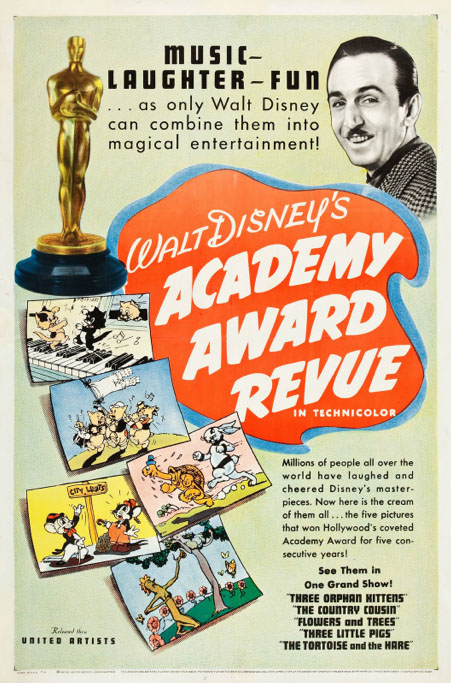
Dewey McGuire asks: Graham Heid seems to have directed only one film, and it’s a good ‘un: Disney’s WYNKEN, BLINKEN & NOD. But he assistant-directed a number of my favorite Disney films under Wilfred Jackson, including MUSIC LAND and MOTHER GOOSE GOES HOLLYWOOD. After his work on FANTASIA, he suddenly turns up missing and is apparently out of the industry altogether. Any idea what happened? The strike? The war? This seems like a brilliant career that ended before it began.
Good question! WYNKEN, BLINKEN & NOD is one of my favorite Silly Symphonies. Heid is rarely mentioned in any animation histories. So I asked Mike Barrier if he knew what happened to Heid – and of course he knew the answer.
Says Barrier, “Graham Heid was at Disney’s for about ten years, until 1945; the last few years, after Bambi, he was involved with live-action military training films. He continued to work in live action after he left Disney, concluding his career as a producer-director of medical teaching films for the U.S. Public Health Service in Atlanta. He retired in 1971 and died in 1976. He told me in a 1975 letter, “I am neither an artist nor a cartoonist, so animation was really not very interesting to me.”
Ben Varkentine asks: I figure this question is going to be maddening either because you’ve answered it a lot or because I don’t have enough information. So I’m sorry in advance. But a couple of friends and I have been trying to find a cartoon we all remember from when we were kids and saw it on television. It’s the story of a man who has a parade pass by the front of his house every day. This wouldn’t be so bad, but the last part of the parade is the sanitation department truck, which always hits a pothole outside his house causing a load of garbage to be dumped outside his house. He goes to see several people to try to get this fixed, explaining the problem in a cod-French accented song. Any ideas? Thank you so much.”
 That cartoon is called LA PETITE PARADE and it’s a Paramount Modern Madcap cartoon from 1959. I get asked about this one a lot. It’s a real cult favorite. It was part of the “Harveytoon” package, shown with Casper, Baby Huey, Herman & Katnip, Little Audrey back in the day, on TV. Hard to see these days. Renoir the Matchmaker is the main character in this film and he appeared in a few more Modern Madcap cartoons during 1960-61. Good news, La Petite Parade is available on DVD. It is contained in episode #41 on HARVEYTOONS: THE COMPLETE COLLECTION.
That cartoon is called LA PETITE PARADE and it’s a Paramount Modern Madcap cartoon from 1959. I get asked about this one a lot. It’s a real cult favorite. It was part of the “Harveytoon” package, shown with Casper, Baby Huey, Herman & Katnip, Little Audrey back in the day, on TV. Hard to see these days. Renoir the Matchmaker is the main character in this film and he appeared in a few more Modern Madcap cartoons during 1960-61. Good news, La Petite Parade is available on DVD. It is contained in episode #41 on HARVEYTOONS: THE COMPLETE COLLECTION.
LISLE BARTMAN asks: Why is Cartoon Network running the Bugs Bunny cartoon “Prince Violent” as “Prince Varmint,” the title made for network-TV broadcast. Some of us would like to see the original opening titles for this ‘toon. Any idea if it will ever be released on video with original opening titles?
Indeed the title change was made for CBS back in the 1970s and you’re right, the correct title should be restored. Cartoon Network accepts what Warner Bros. hands them off the shelf.
Jon Cooke adds “Warners made a NEW set of titles for this short (along with most of the made-for-TV shorts, like “Soup or Sonic”, etc.) for Fox’s MERRIE MELODIES STARRING BUGS BUNNY & FRIENDS in 1992. The syndicated MERRIE MELODIES STARRING BUGS BUNNY & FRIENDS (1990) did use the CBS-titled version, though. I have provided (below) the modern title card as seen on CN (note the “1961” copyright on a title card itself!)”.
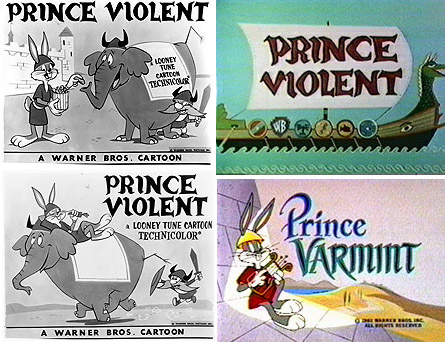
Original lobby cards (at left); Original title (top right), 1992 re-title (bottom right), courtesy of Jon Cooke.
Carmen Margiatto writes: I’ve stumbled onto your site while trying to find the name of a piece of music used in several Warner Brother’s classic cartoons and hope you can shed some light my way.
Since it’s been used in several shorts, I’ll describe what I believe is the most likely one you will recall hearing it in. The cartoon is the 1944 Buckaroo Bugs, and the piece is a gallop (in two distinctive parts) that is played while Red Hot Ryder is jumping over larger and larger crevasses until he attempts a jump over the Grand Canyon. Once he realizes that he isn’t going to make the jump and will now fall, the gallop goes into its second theme; I’m assuming it’s the same piece, because the two parts are always heard together whenever played.
I have no clue if this is a classical piece, or one dreamed up by Carl Stalling himself (I’m pretty sure it’s not Raymond Scott). Thanks for any information you can pass my way.
Great question! I directed your query to cartoon music historian extrordainaré Daniel Goldmark, and here is his reply:
“That piece of music is called “IN THE STIRRUPS” by J.S. Zamecnik, who was a prolific composer of music for silent movie theatres.
A former music accompanist such as Stalling would be quite familiar with Zamecnik’s work and IN THE STIRRUPS can be heard in a total of 14 Warner Bros. cartoons including Clampett’s DRAFTEE DAFFY, TORTOISE WINS BY A HARE and THE OLD GREY HARE – as well as the race & chase epics BUDDY’S PONY EXPRESS, PORKY & TEABISCUIT and THE GREY HOUNDED HARE.”
tservo2049 asks: Tell me everything about Fred Ladd. Give me the history and chronology of his companies, the information you know now. Were his 4 companies (Delphi Associates, Radio & Television Packagers, Color Systems Inc., and Entercolor Technologies) related in any way? If so, when did they become one of the other companies? I need this info desperately!
 “Desparately”?? Fred Ladd certainly holds a special place in animation history. He was the first to bring anime to American TV, produced a few animated features and colorized Porky Pig, Betty Boop and Popeye cartoons. You can read more about Fred Ladd in this AWN INTERVIEW by Harvey Deneroff, and you can see more of his work at the Colorized Cartoons Database.
“Desparately”?? Fred Ladd certainly holds a special place in animation history. He was the first to bring anime to American TV, produced a few animated features and colorized Porky Pig, Betty Boop and Popeye cartoons. You can read more about Fred Ladd in this AWN INTERVIEW by Harvey Deneroff, and you can see more of his work at the Colorized Cartoons Database.
Here is a timeline of his career, with the emphasis on animation. He has worked on importing and dubbing many live action films, which I skip over in order to concentrate on our interests here. Fred is still working in Encino, California.
 1950-60 – Radio & Television Packagers (Cartoon Classics, Space Explorers) Fred is employee of this company, not owner.
1950-60 – Radio & Television Packagers (Cartoon Classics, Space Explorers) Fred is employee of this company, not owner.
1960 – Fred producing/writing PINOCCHIO IN OUTER SPACE
1963 – JOURNEY BACK TO OZ (writing/producing)
1963 – “Little Adam Productions” (The Big World of Little Adam) – also dubbed Toel features for A.I.P. (Little Norse Prince, Puss In Boots, Treasure Island, etc)
March 1963 – began Astro Boy dubbing as work-for-hire, for NBC Enterprises
1964 – “Delphi Associates” starts with GIGANTOR
Oct. 1965 – “Kimba” dubbing work-for-hire
1966 – dubbed pilot of SPACE ACE (RING-O) never sold
1967 – Begins colorizing experiments
1968 – COLOR SYSTEMS, INC. (partnered with Elliot Hyman) begins with 78 Porky Pig cartoon, 100 Betty Boops, 18 Krazy Kats, test of FARMER AL FALFA, Mutt & Jeff cartoons; colorized 43 PD cartoons (including Felix, Bosko & Buddy titles) for former employer Radio & Television Packagers.
1974 – Dissolved COLOR SYSTEMS
1975 – Sets up GREATEST TALES INC. (to dub Japanese animated fairy tales (Snow Queen, Hansel & Gretal) for institutional market)
1974-84 various dubbing projects mainly live action; established PLAID PRODUCTIONS with Graham Place (Fleischer animator) did commercials, TALES OF THE GOOD BOOK (animated Bible stories). Note: Elliot Hyman dies July 23, 1980
1984 – Ladd in Los Angeles starts ENTERCOLOR TECHOLOGIES CORP. Columbia’s Barney Googles, L’iL Abner, Oswald The Rabbit test, ten Mickey Mouse cartoons.
1986-87 – Entercolor colorizes Fleischer POPEYE cartoons for Turner – also 26 Turner Merrie Melodies and MGM Captain & The Kids titles. Ladd re-dubs G-FORCE (a re-do of BATTLE OF THE PLANETS) also for Turner.
1992 – dubbed color GIGANTOR episodes for Sci-Fi Channel
1995 – creative consultant on SAILOR MOON dubbing
2021 – Fred Ladd passes away.
PEBYRNE writes:I’m looking for information about a cartoon from my childhood – I think the name is “Snowman in July.” It’s about a snowman who is kept frozen in a freezer so he can see warm weather in July. It might be foreign. Any information you can provide will be appreciated.
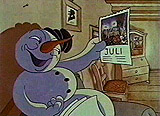 The cartoon many know as SNOWMAN IN JULY was originally called THE SNOWMAN (or “Der Schneemann”), which was produced in Nazi Germany in 1943 by Hans Fischerkoesen. Fischerkosen (1896-1973) was a great German cartoonist/producer who produced short color theatrical cartoons during the wartime era. Some of them were acquired, along with many other Europeon cartoons, for U.S. TV distribution in the 1950s in cartoon packages with names like CAPTAIN SAILORBIRD and BOZO’S STORYBOOK.
The cartoon many know as SNOWMAN IN JULY was originally called THE SNOWMAN (or “Der Schneemann”), which was produced in Nazi Germany in 1943 by Hans Fischerkoesen. Fischerkosen (1896-1973) was a great German cartoonist/producer who produced short color theatrical cartoons during the wartime era. Some of them were acquired, along with many other Europeon cartoons, for U.S. TV distribution in the 1950s in cartoon packages with names like CAPTAIN SAILORBIRD and BOZO’S STORYBOOK.
MATTHEW HUNTER asks: Many Warner animation books (including yours I believe) mention a special from the 1970’s called “Daffy Duck and Porky Pig meet the Groovie Ghoulies.” It was an experiment by Warner Brothers in loaning their characters to another studio, Filmation I think. I think it wound up as a one-shot special with limited TV release. Everything I have heard (which is very little) about this special has been bad, and it is cited as being a worse teamup than Daffy and Speedy Gonzales ever were. Several questions: Whatever happened to it? What is a “Groovie Ghoulie?!” What is the special about?
 I am sure there are many WB cartoon fans out there ask themselves the same three questions. Could your page be so kind as to become the first in history to unmask the mystery?
I am sure there are many WB cartoon fans out there ask themselves the same three questions. Could your page be so kind as to become the first in history to unmask the mystery?
Here’s a “Lost Warner Bros. Cartoon” that should remain lost, forever!
DAFFY DUCK AND PORKY PIG MEET THE GROOVIE GOOLIES (note the spelling of “Goolies”) was first telecast on Dec. 18, 1972 as part of the ABC SATURDAY SUPERSTAR MOVIE, a weekly Saturday morning series that featured special one hour episodes and one-shots, by different animation studios. The “Groovie Goolies” had their own show on CBS the previous season, and were introduced on SABRINA AND THE GROOVIE GOOLIES in 1970. They were a rock group of monsters, an erzatz MUNSTERS (Drac, Frankie, Wolfie, Mummy, Hagatha, etc.)
The Looney Tunes characters involved here were Daffy, Porky, Elmer, Yosemite Sam, Tweety, Petunia Pig (voice by Jane Webb), Wile E. Coyote, Foghorn Leghorn, Pepe LePew, and Sylvester. Mel Blanc provides the Warner character voices and he sounds pretty good here, with the exception of an awful baritone Elmer Fudd, and Daffy & Tweety who are sped up way too much, sounding like they are on helium! The Looney Tunes are drawn reasonably well with the exception of Pepe and Wile E. who look particularly terrible.
Needless to say, this Filmation production is an abominable mess, with limited animation and an annoying laugh track (not to mention the bland stock background muzak). I’d be happy to provide a plot synopsis, but keep in mind, the film sounds better than it is:
PLOT SYNOPSIS: The Groovie Goolies are at home watching a TV interview of Petunia Pig interviewing Daffy Duck about his latest movie “King Arthur and the Knights of the Round Table”. A clip is shown: Foghorn is King Arthur, Sylvester is his loyal jester. Foggy asks Sylvester to take his new son (an egg) for a walk. While walking, Sylvester decides to eat the egg. Tweety tries to stop him, but the egg hatches. Daffy (as Arthur in a baby bonnet) emerges.
At this point, “The Phantom Of The Flickers” (a Karloffian character) interupts the show and promises to distrupt all of Daffy Duck’s movies. The Goolies decide to go to Hollywood to help save Daffy’s films.
To make a long convoluted story short: The Goolies arrive at “Daffy Duck Studios” where the Toon Squad mistakes the Goolies for stuntmen, then for the Phantom themslves. They chase around the studio, eventually stopping to screen the rest of the “King Arthur” film. In the film within a film, Arthur (Daffy) asks Merlin’s (Porky) help in winning the hand of Lady Guinevere (Petunia). Daffy pulls the sword from the stone, infuriating Mordred (Yosemite Sam) who challenges Daffy to a joust.
The Phantom stops the screening and grabs the film. The Goolies & Looneys chase after him and corner him on a pirate ship set. The Phantom get’s away and disguises as a little boy, hiding the film in his guitar. He runs into “Mad Mirror Land” and he and three of the Goolies become live action (!!). This is the best part of the picture, as the Goolies chase the kid using pixilation techniques. They chase into a western town set, then get distracted and begin to play music. Frankie grabs the guitar and his gigantic sneezes force the whole group through the mirror and back into cartoon land.
(Are you still following this?)
The Phantom is revealed to be Claude Chaney, Drac’s long lost uncle, a formerly famous actor who wanted revenge for movies going to color (??). Daffy gives Chaney a job, “King Arthur” wins an Ozzie Award, and the Goolies go home. The last scenes has some of the Looney Tunes, led by Sam, following the Goolie gang home to their castle.
AVOID THIS STINKER AT ALL COSTS! It is very sad to see our favorite characters this way. If this plot synopsis spares even one of you from ever seeing this cartoon, then I have done my job.
SIMON asks: Some sources list Clampett’s “It’s A Grand Old Nag” (1947) as the only cartoon released by Republic, but I’ve also seen references to a series of travelogue spoofs called “Jerky Journies” that were apparently released in ’49 by Republic. Do you know anything about these cartoons? Were they really released? Are they all lost now? Do you know who worked on them?
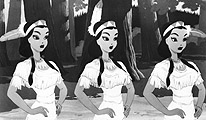 The JERKY JOURNEYS were indeed released. There were only four. Republic was a low budget studio and I suspect that they were interested in promoting their “TruColor” process. Cartoons were a great way of doing that. Bob Clampett’s “Charlie Horse” cartoon (released 12/1/47) cost $20,000. to produce. Republic got four JERKY JOURNEYS for a total of $46,787. This was possible because there is almost no animation in these films!
The JERKY JOURNEYS were indeed released. There were only four. Republic was a low budget studio and I suspect that they were interested in promoting their “TruColor” process. Cartoons were a great way of doing that. Bob Clampett’s “Charlie Horse” cartoon (released 12/1/47) cost $20,000. to produce. Republic got four JERKY JOURNEYS for a total of $46,787. This was possible because there is almost no animation in these films!
Producer Leonard Lewis Levinson’s Impossible Pictures partnered with Art Heineman to make these gag travelouges which depended on verbal humor and long pan backgrounds. Amid Amidi did an interview with Pete Alvarado in ANIMATION JOURNAL (Vol. 8 #1, Fall 1999 – available from Chapman University) who says he, Paul Julian and Robert Gribbroek moonlighted from Warners painting the backgrounds over Heineman’s layouts. Like Avery’s Travelouge spoofs, but with hardly any action, one was even done in the style of a narrated slide show. Frank Nelson provided most of the voices. Here’s the whole list:
BEYOND CIVILIZATION TO TEXAS (3/15/49)
THE 3 MINNIES: SOTA, TONKA & HA HA! (4/15/49)
BUNGLE IN THE JUNGLE (5/15/49)
ROMANTIC RUMBOLIA (6/15/49)
SIMON also asks: A similar question, were Iwerks’ “Granpop Monkey” cartoons ever released? Another case of conflicting sources, I’ve read that they were released through Monogram, but I’ve also read that they were never even completed. If they were completed, do any prints exist?
Three cartoons starring “Three Monkeys” were released in 1940 by Monogram: A BUSY DAY, THE BEAUTY SHOPPE and BABY CHECKERS. I believe these were produced by Ub Iwerks, sponsored by Boots Chemists in England and picked up by B-studio Monogram for U.S. distribution. These films still exist in private collections. There is a VHS tape available from The Whole Toon Catalog called “British and Australian Cartoons” that contains A BUSY DAY and THE BEAUTY SHOPPE.
MOE HARE asks: I would like to know if any of the “Toby The Pup” cartoons survived in any kind of form? I know that Charles Mintz produced the series and was released by RKO/Radio pictures and wouldn’t Turner own the rights to the films today? Do you have any kind of images of Toby? And will any of these cartoons make it to video someday.
 Until recently, only a fragment (about half) of TOBY IN THE MUSEUM was the only “Toby” cartoon around. Four prints were discovered in Europe within the last eight years. TOBY IN CIRCUS TIME was preserved by the UCLA FILM ARCHIVE and a great 35mm print exists in their vaults. TOBY THE MILKMAN, DOWN SOUTH and HALLOWEEN all showed up on TV in France (the program CARTOON FACTORY on Arte). The rest have been found at various archives in Europe and in private collectors hands. Thunderbean Animation is planning a “complete” set on DVD/blu-ray, hopefully in 2021.
Until recently, only a fragment (about half) of TOBY IN THE MUSEUM was the only “Toby” cartoon around. Four prints were discovered in Europe within the last eight years. TOBY IN CIRCUS TIME was preserved by the UCLA FILM ARCHIVE and a great 35mm print exists in their vaults. TOBY THE MILKMAN, DOWN SOUTH and HALLOWEEN all showed up on TV in France (the program CARTOON FACTORY on Arte). The rest have been found at various archives in Europe and in private collectors hands. Thunderbean Animation is planning a “complete” set on DVD/blu-ray, hopefully in 2021.
I believe they’ve all fallen into the Public Domain. No one has the original negatives, though I suppose RKO had them in the 1930s and they could still be in some RKO storage somewhere, if anyone cared enough to look. Turner’s rights (now Warner Bros.) to RKO films is limited to TV distribution of feature films only. RKO, which still exists as a corporate entity, I believe still owns all other rights to their properties. Mike Barrier says in his book, HOLLYWOOD CARTOONS, that Dick Huemer joined the Charles Mintz studio to make the Toby series (in 1930). The following year, Huemer created the Scrappy cartoons for Columbia release (for whom Mintz had already been doing the KRAZY KAT cartoons).
Buzz Dixon asks: Back in the early 60s I saw a “serial” on a local morning kid show in Asheville, N.C. (I say “serial” because they ran other cartoons “serials” that were originally features, such as THE ADVENTURES OF MR. WONDERBIRD and several Russian fairy tale featurettes). The name of the serial was THE SPACE ADVENTURERS or something like that (in the mid-to-late 70s Universal 16 listed a film in their catalog that sounded very close to the cartoon I’d seen; that is the only published reference to it I’ve ever seen).
The plot involved a young boy stowing away on a spaceship that was taking off to rescue his missing father, who had disappeared on an earlier spaceflight. What made the story quite memorable, however, was that the rockets and spaceflight scenes were live action miniatures, not cartoon animation as the rest of the movie. In fact, the live action footage came from an abandoned Barvarian film called ROCKETSHIP ONE TAKES OFF (or some simimlar variant title). Stills from ROCKETSHIP ONE can be found in several sources and a clip (without cartoon animation interior shots) ran on a Discovery channel special on spaceflight last year. My questions are (a) what is the origin of SPACE ADVENTURERS and (b) is it available on tape or disc anywhere?
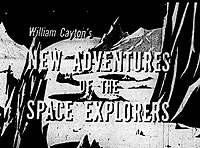 According to ace cartoon researcher Ray Pointer, the plot goes like this: “Jimmy’s father was “Commander Perry,” and the spaceship that he took to Mars was The Polaris! (You get the picture?) When Jimmy heard that the Polaris was lost, he stowed away in a shipping crate that was loaded onto the rescue ship, The Polaris II, was commanded by the Professor and Smitty, his female assistant.
According to ace cartoon researcher Ray Pointer, the plot goes like this: “Jimmy’s father was “Commander Perry,” and the spaceship that he took to Mars was The Polaris! (You get the picture?) When Jimmy heard that the Polaris was lost, he stowed away in a shipping crate that was loaded onto the rescue ship, The Polaris II, was commanded by the Professor and Smitty, his female assistant.
“When Jimmy is revealed, the journey becomes a “vehicle” to teach astronomy. As it turned out, they stopped at the Moon, and it was there that Jimmy accidentally finds his father who has crash landed there, never landing on Mars. He did manage to bring back a several valuable photographs of the planet taken from outer space.”
According to Fred Ladd, he took a half-hour Eastern Europeon animated short film (he couldn’t remember the original title), and made a two-hour movie of it by reruning and reusing the footage, and padding it with live action spaceship shots from a German film called Weltraumschiff 1 Startet and outer space and planet shots from a Europeon feature called UNIVERSE.
Because the Sputnik craze was so hot, they rushed the first hour of THE SPACE EXPLORERS to television as soon as it was finished. They then released the second hour, a few months later, as THE NEW ADVENTURES OF THE SPACE EXPLORERS. In the 1960s, Ladd cut the film into 6 minute episodes for syndication!
According to Ray Pointer, “The sequel, THE NEW ADVENTURES OF THE SPACE EXPLORERS reused material from the first with a new twist. The professor tricks Jimmy into going with him on a mission to Mars to retrieve a defective data gathering satellite.
“In this one, aspects of Einstein’s Theories are explained along with other interesting scientific information. Thinking back on it, I found that they cleverly integrated film footage with intelligent writing and made an entertaining educational series that keep this five year old excited about the prospects of interplanetary travel.
“There was a similar educational series like this called JOURNEY TO THE BOTTOM OF THE SEA. It was similar in concept to SPACE EXPLORERS, made up of Eastern European animation cut together with live action footage about undersea life. Again, well done, but I liked SPACE EXPLORERS better. There was also another serialized adventure, JOURNEY TO THE BEGINNING OF TIME, but this was entirely live action cut together with the same narrative technique used in the other two series.”
More SPACE EXPLORERS info Click Here.
 JON COOKE asks: Do any pictures of Buzzy Boop exist (the title character of two of the lost Boop cartoons)? I think it would be interesting to see what she looks like.
JON COOKE asks: Do any pictures of Buzzy Boop exist (the title character of two of the lost Boop cartoons)? I think it would be interesting to see what she looks like.
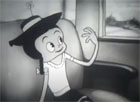 Buzzy Boop, Betty’s michievous niece, appeared in two cartoons which for years were considered lost. Neither was ever in the U.M.&M. TV package (and thus not contained in the Republic “Definitive Betty Boop” VHS and Laser collections), but luckily a dupe 16mm print of the first one BUZZY BOOP survives in some private collections. The second one BUZZY BOOP AT THE CONCERT was located in Russia in 2019 – and preserved by Asifa-Hollywood and The UCLA Film and Television Archive in 2020.
Buzzy Boop, Betty’s michievous niece, appeared in two cartoons which for years were considered lost. Neither was ever in the U.M.&M. TV package (and thus not contained in the Republic “Definitive Betty Boop” VHS and Laser collections), but luckily a dupe 16mm print of the first one BUZZY BOOP survives in some private collections. The second one BUZZY BOOP AT THE CONCERT was located in Russia in 2019 – and preserved by Asifa-Hollywood and The UCLA Film and Television Archive in 2020.
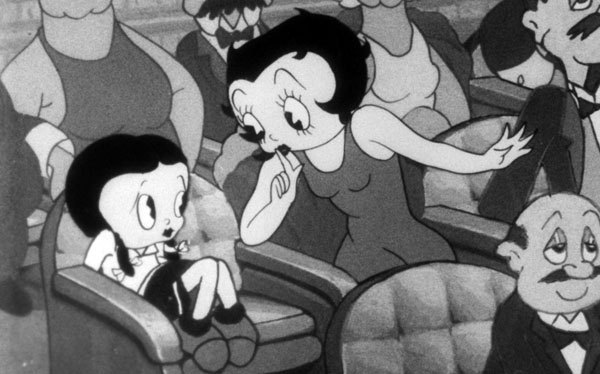
A frame from the recently found and preserved “Buzzy Boop At The Concert”
Copyright © 2021 Jerry Beck


 Jerry Beck is a writer, animation producer, college professor and author of more than 15 books on animation history. He is a former studio exec with Nickelodeon Movies and Disney, and has written for The Hollywood Reporter and Variety. He has curated cartoons for DVD and Blu-ray compilations and has lent his expertise to dozens of bonus documentaries and audio commentaries on such. Beck is currently on the faculty of CalArts in Valencia, UCLA in Westwood and Woodbury University in Burbank – teaching animation history. More about Jerry Beck [
Jerry Beck is a writer, animation producer, college professor and author of more than 15 books on animation history. He is a former studio exec with Nickelodeon Movies and Disney, and has written for The Hollywood Reporter and Variety. He has curated cartoons for DVD and Blu-ray compilations and has lent his expertise to dozens of bonus documentaries and audio commentaries on such. Beck is currently on the faculty of CalArts in Valencia, UCLA in Westwood and Woodbury University in Burbank – teaching animation history. More about Jerry Beck [



